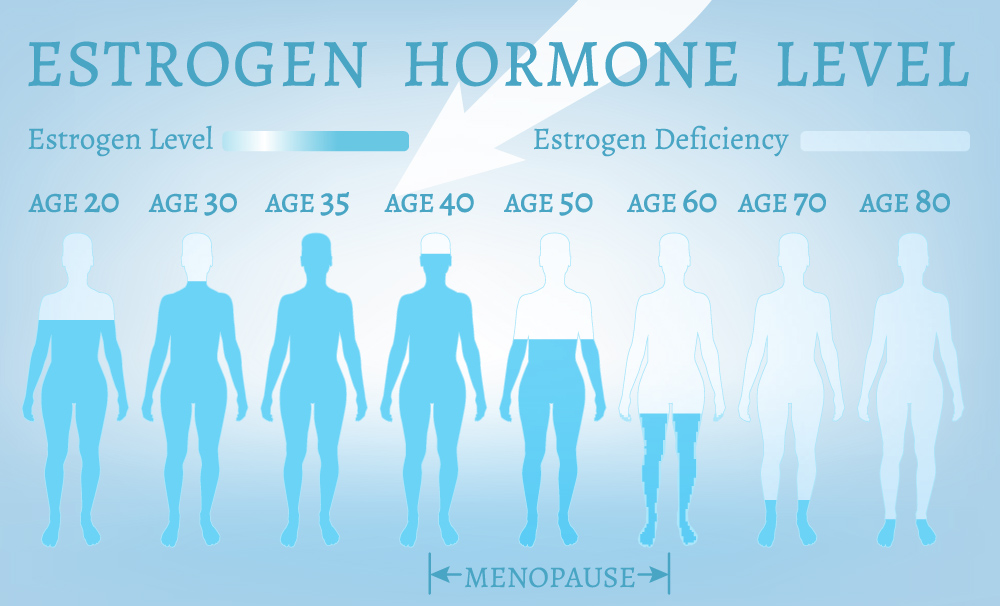03 Aug
Estrogen is one of two primary female hormones, and it plays a leading role in women’s health during various stages of life. Alongside progesterone, estrogen kick-starts physical changes during puberty, controls the menstrual cycle, maintains pregnancy, keeps healthy skin, and strengthens bones.
There is no ‘perfect’ level of estrogen, and it varies widely – between different women, during different stages of the menstrual cycle, and over the course of a lifetime.
Why Do Estrogen Levels Change?
Female hormones fluctuate through puberty, pregnancy, and menopause to facilitate important changes in the body. Weight gain, certain medications, excessive exercise, extreme dieting, and other lifestyle factors can cause estrogen to rise or drop.
Several health and age factors play a role in estrogen production including polycystic ovarian syndrome (PCOS), underactive pituitary gland, diabetes, and more.
There are three main types of estrogen, and each one varies in purpose and strength. After menopause, the female body only produces estrone, which is the weakest form. Even with ‘normal’ estrogen levels, many peri-menopausal and post-menopausal women struggle to maintain normalcy. Vaginal dryness, mood swings, diminished sex drive, and hot flashes can range from mild symptoms to severe discomfort.

Both young and menopausal women can be affected by hormone imbalance
Managing Symptoms – Replace or Repair?
Hormone Replacement
Hormone replacement therapy (HRT) became a popular treatment for menopausal symptoms in the late 1990s and 2000s. This therapy was designed to elevate estrogen levels after ovarian aging.
With an added dose of systemic estrogen, many women are able to reverse or avoid the most severe menopausal symptoms. However, there are risks.
Clinical trials and follow-up studies have found that HRT increases the risk of heart disease, stroke, blood clots, and cancer – especially when therapy is started after the age of 60.
Cancer survivors cannot use HRT because it speeds up the growth of cancer cells. For many women, potential risks outweigh the benefits.
Homeopathic Remedies
There are also a variety of homeopathic herbal supplements that supposedly enhance estrogen levels and symptoms. Soybeans, flax seeds, and sesame seeds are natural sources of phytoestrogens, which may mimic estrogen-like benefits.
Emerging research is also considering how DHEA, boron, vitamin B, and vitamin D impact estrogen metabolism in the body.
Vaginal Repair
It is natural for estrogen levels to decline after menopause and through hormonal transition periods, like after giving birth.
According to Harvard Health, 50% of postmenopausal women suffer from vaginal dryness, irritation, and pain during sex. New laser technology makes it possible to target the source of discomfort without modifying or supplementing hormone levels.
The FemiLift CO2 laser is an outpatient treatment that penetrates the vaginal walls with thermally induced 360-degree fractional laser beam. Essentially, the laser focuses precise heat to warm your vaginal tissue without excessive pain or damage.
A proprietary technology of a fractional laser beam results in controlled combination of micro-ablation and mild temperature increase. This effect instantly increases blood flow in the vaginal walls and boosts collagen production to facilitate natural repair. In clinical studies, 80% of women treated with the FemiLift laser reported a more comfortable sexual response with natural lubrication. On op of that they have also experienced improved control of urination!
Unlike HRT, FemiLift does not alter the delicate balance of female hormones. This painless laser therapy increases comfort and confidence through life’s natural ups and downs with estrogen.




Sorry, the comment form is closed at this time.